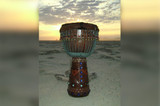A Passion for Hand Percussion: Batá Drums
Drums are considered to represent the cultures and regions from which they were developed, whether used as ceremonial instruments within a tribe or long-distance tools of communication upon a battlefield. When studying a culture, the music and instruments that are created are often unique to that area’s natural materials, as well as the spiritual practices that can date back hundreds and thousands of years. These concepts are definitively reflected in the Batá drum as a representation of Nigerian culture, Yoruba tribes and the Afro-Cuban musical (and religious) traditions we see today.
Batá drums are thought to be around 500 years old, originating from Nigeria as a hand percussion instrument for spiritual practices. However, these drums were not well known until the 1800s, due to their presence in Cuba after slaves were “traded” across the ocean from Africa. Much like other African hand percussion instruments, Batá drums were not favored by the majority population in Cuba, rendering these drums another “hidden” aspect of Afro-Cuban life. Today, Batá drums are best known for their role in the Santeria religion, although, there has been an inclusion of Batá rhythms in modern music and in parades and festivals that celebrate Afro-Cuban culture and Santeria.
As with many other African hand percussion instruments, Batá drums consist of a set of drums that harmonize with each other. Cuban Batá drums can be found in sets of three drums, the Oconcolo Batá, Itolele Batá, and Iya Batá, while the original, Nigerian Batá drums are often found in sets of five. The drums are laid across the lap of the drummer, or, strapped sideways, and played with a mallet or a rattle. By using the rattle, there is a richer sound possible that increases the harmonics of the rhythms played. Both sides of the drum are struck with the mallet or rattle, as well, with alternating hands providing a diverse beat that is unique to these drums.
While many feel that Batá drums are solely for the purpose of the spiritual practices and cultures from where they originated, many hand percussion enthusiasts are eagerly bringing these drums from the shadows, and into the spotlight. With a unique design, sound and method of play, as well as a reverence for the cultural ties to Africa and Cuba, Batá drums are certain to continue to find a place in modern music, drum circles and the rhythms we all hold sacred.
Recent Posts
-
What is the Best Size Djembe for Beginners?
If you're new to the world of percussion and interested in learning the djembe, you're in for a t …16th Jul 2024 -
The Benefits of Becoming a Drumming Teacher: Transforming Passion into Profession
Why become a drumming teacher? Becoming a drumming teacher is an excellent way to share your pas …22nd May 2024 -
What Makes the Djembe Drum a Spiritual Instrument in African Music?
Origin and history of the Djembe drum The Djembe drum originates from West Africa and holds sign …16th May 2024



